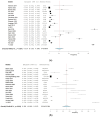The Frequency of Urination Dysfunction in Patients Operated on for Rectal Cancer: A Systematic Review with Meta-Analyses
- PMID: 39451746
- PMCID: PMC11505854
- DOI: 10.3390/curroncol31100442
The Frequency of Urination Dysfunction in Patients Operated on for Rectal Cancer: A Systematic Review with Meta-Analyses
Abstract
The frequency of long-term urination dysfunction after surgery for rectal cancer remains unclear, yet it is essential to establish this to improve treatment strategies. Randomized controlled trials (RCTs), non-RCTs, and cohort studies were included with patients having undergone sphincter-preserving total (TME) or partial mesorectal excision (PME) for the treatment of primary rectal cancer in this review. The outcome was urination dysfunction reported at least three months postoperatively, both overall urination dysfunction and subdivided into specific symptoms. The online databases PubMed, Embase, and Cochrane CENTRAL were searched, bias was assessed using the Newcastle-Ottawa scale, and results were synthesized using one-group frequency meta-analyses. A total of 55 studies with 15,072 adults were included. The median follow-up was 29 months (range 3-180). The pooled overall urination dysfunction was 21% (95% confidence interval (CI) 12%-30%) 3-11 months postoperatively and 25% (95% CI 19%-32%) ≥12 months postoperatively. Retention and incontinence were common 3-11 months postoperatively, with pooled frequencies of 11% and 14%, respectively. Increased urinary frequency, retention, and incontinence seemed even more common ≥12 months postoperatively, with pooled frequencies of 37%, 20%, and 23%, respectively. In conclusion, one in five patients experienced urination dysfunction more than a year following an operation for rectal cancer.
Keywords: late complications; rectal cancer; total mesorectal excision; urinary incontinence; urinary retention; urination disorders.
Conflict of interest statement
The authors declare no conflicts of interest.
Figures



Similar articles
-
Laparoscopic versus open total mesorectal excision for rectal cancer.Cochrane Database Syst Rev. 2014 Apr 15;2014(4):CD005200. doi: 10.1002/14651858.CD005200.pub3. Cochrane Database Syst Rev. 2014. PMID: 24737031 Free PMC article.
-
Drugs for preventing postoperative nausea and vomiting in adults after general anaesthesia: a network meta-analysis.Cochrane Database Syst Rev. 2020 Oct 19;10(10):CD012859. doi: 10.1002/14651858.CD012859.pub2. Cochrane Database Syst Rev. 2020. PMID: 33075160 Free PMC article.
-
Systemic pharmacological treatments for chronic plaque psoriasis: a network meta-analysis.Cochrane Database Syst Rev. 2021 Apr 19;4(4):CD011535. doi: 10.1002/14651858.CD011535.pub4. Cochrane Database Syst Rev. 2021. Update in: Cochrane Database Syst Rev. 2022 May 23;5:CD011535. doi: 10.1002/14651858.CD011535.pub5. PMID: 33871055 Free PMC article. Updated.
-
Postoperative adjuvant chemotherapy in rectal cancer operated for cure.Cochrane Database Syst Rev. 2012 Mar 14;2012(3):CD004078. doi: 10.1002/14651858.CD004078.pub2. Cochrane Database Syst Rev. 2012. PMID: 22419291 Free PMC article.
-
Use of endoanal ultrasound for reducing the risk of complications related to anal sphincter injury after vaginal birth.Cochrane Database Syst Rev. 2015 Oct 29;2015(10):CD010826. doi: 10.1002/14651858.CD010826.pub2. Cochrane Database Syst Rev. 2015. PMID: 26513224 Free PMC article.
Cited by
-
Association of urinary dysfunction after lower rectal cancer surgery with renal function: a single-center study.Int J Colorectal Dis. 2025 Jul 14;40(1):158. doi: 10.1007/s00384-025-04955-1. Int J Colorectal Dis. 2025. PMID: 40658254 Free PMC article.
References
-
- Ferlay J., Ervik M., Lam F., Laversanne M., Colombet M., Mery L., Pineros M., Znaor A., Soerjomataram I., Bray F. Cancer Site Ranking. 2024. [(accessed on 19 August 2024)]. Available online: https://gco.iarc.who.int/media/globocan/factsheets/cancers/39-all-cancer....
Publication types
MeSH terms
LinkOut - more resources
Full Text Sources
Medical
Research Materials

